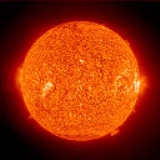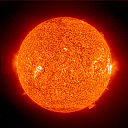
Facula
Encyclopedia
- For the genusGenusIn biology, a genus is a low-level taxonomic rank used in the biological classification of living and fossil organisms, which is an example of definition by genus and differentia...
of gossamer-winged butterflies, see Facula (butterfly)Facula (butterfly)Facula is a genus of butterfly in the family Lycaenidae....
.

Planetary nomenclature
Planetary nomenclature, like terrestrial nomenclature, is a system of uniquely identifying features on the surface of a planet or natural satellite so that the features can be easily located, described, and discussed. The task of assigning official names to features is taken up by the International...
for naming certain surface features of planets and moons, and is also a type of surface phenomenon on the Sun
Sun
The Sun is the star at the center of the Solar System. It is almost perfectly spherical and consists of hot plasma interwoven with magnetic fields...
.
Solar faculae are bright spots that form in the canyons between solar granules
Granule (solar physics)
Granules on the photosphere of the Sun are caused by convection currents of plasma within the Sun's convective zone. The grainy appearance of the solar photosphere is produced by the tops of these convective cells and is called granulation.The rising part of the granules is located in the center...
, short-lived convection cells several thousand kilometers across that constantly form and dissipate over timescales of several minutes. Faculae are produced by concentrations of magnetic field lines.
The chromosphere is above the photosphere. Solar energy passes through this region on its way out from the center of the Sun. Faculae and flares arise in the chromosphere. Faculae are bright luminous hydrogen clouds which form above regions where sunspots are about to form. Flares are bright filaments of hot gas emerging from sunspot regions. Sunspots are dark depressions on the photosphere with a typical temperature of 4,000°C (7,000°F).
source:
http://www.solarviews.com/eng/sun.htm

